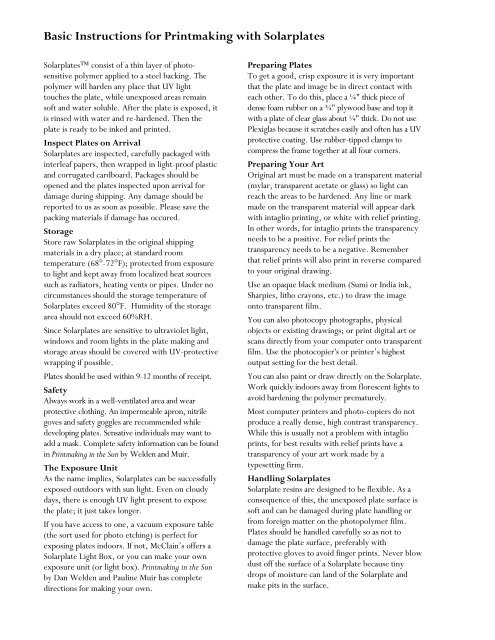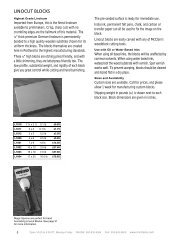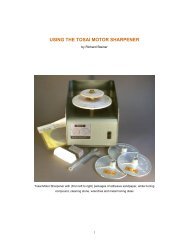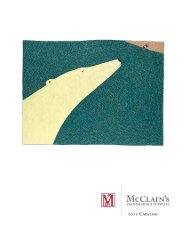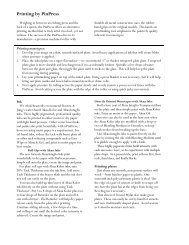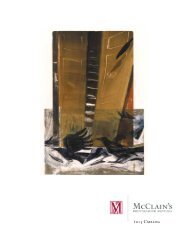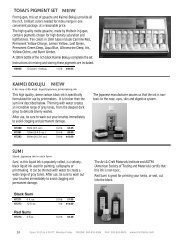Basic Instructions for Printmaking with Solarplates - McClain's ...
Basic Instructions for Printmaking with Solarplates - McClain's ...
Basic Instructions for Printmaking with Solarplates - McClain's ...
You also want an ePaper? Increase the reach of your titles
YUMPU automatically turns print PDFs into web optimized ePapers that Google loves.
<strong>Basic</strong> <strong>Instructions</strong> <strong>for</strong> <strong>Printmaking</strong> <strong>with</strong> <strong>Solarplates</strong><br />
<strong>Solarplates</strong> consist of a thin layer of photosensitive<br />
polymer applied to a steel backing. The<br />
polymer will harden any place that UV light<br />
touches the plate, while unexposed areas remain<br />
soft and water soluble. After the plate is exposed, it<br />
is rinsed <strong>with</strong> water and re-hardened. Then the<br />
plate is ready to be inked and printed.<br />
Inspect Plates on Arrival<br />
<strong>Solarplates</strong> are inspected, carefully packaged <strong>with</strong><br />
interleaf papers, then wrapped in light-proof plastic<br />
and corrugated cardboard. Packages should be<br />
opened and the plates inspected upon arrival <strong>for</strong><br />
damage during shipping. Any damage should be<br />
reported to us as soon as possible. Please save the<br />
packing materials if damage has occured.<br />
Storage<br />
Store raw <strong>Solarplates</strong> in the original shipping<br />
materials in a dry place; at standard room<br />
temperature (68°-72°F); protected from exposure<br />
to light and kept away from localized heat sources<br />
such as radiators, heating vents or pipes. Under no<br />
circumstances should the storage temperature of<br />
<strong>Solarplates</strong> exceed 80°F. Humidity of the storage<br />
area should not exceed 60%RH.<br />
Since <strong>Solarplates</strong> are sensitive to ultraviolet light,<br />
windows and room lights in the plate making and<br />
storage areas should be covered <strong>with</strong> UV-protective<br />
wrapping if possible.<br />
Plates should be used <strong>with</strong>in 9-12 months of receipt.<br />
Safety<br />
Always work in a well-ventilated area and wear<br />
protective clothing. An impermeable apron, nitrile<br />
goves and safety goggles are recommended while<br />
developing plates. Sensative individuals may want to<br />
add a mask. Complete safety in<strong>for</strong>mation can be found<br />
in <strong>Printmaking</strong> in the Sun by Welden and Muir.<br />
The Exposure Unit<br />
As the name implies, <strong>Solarplates</strong> can be successfully<br />
exposed outdoors <strong>with</strong> sun light. Even on cloudy<br />
days, there is enough UV light present to expose<br />
the plate; it just takes longer.<br />
If you have access to one, a vacuum exposure table<br />
(the sort used <strong>for</strong> photo etching) is perfect <strong>for</strong><br />
exposing plates indoors. If not, McClain’s offers a<br />
Solarplate Light Box, or you can make your own<br />
exposure unit (or light box). <strong>Printmaking</strong> in the Sun<br />
by Dan Welden and Pauline Muir has complete<br />
directions <strong>for</strong> making your own.<br />
Preparing Plates<br />
To get a good, crisp exposure it is very important<br />
that the plate and image be in direct contact <strong>with</strong><br />
each other. To do this, place a ¼" thick piece of<br />
dense foam rubber on a ¾" plywood base and top it<br />
<strong>with</strong> a plate of clear glass about ¼" thick. Do not use<br />
Plexiglas because it scratches easily and often has a UV<br />
protective coating. Use rubber-tipped clamps to<br />
compress the frame together at all four corners.<br />
Preparing Your Art<br />
Original art must be made on a transparent material<br />
(mylar, transparent acetate or glass) so light can<br />
reach the areas to be hardened. Any line or mark<br />
made on the transparent material will appear dark<br />
<strong>with</strong> intaglio printing, or white <strong>with</strong> relief printing.<br />
In other words, <strong>for</strong> intaglio prints the transparency<br />
needs to be a positive. For relief prints the<br />
transparency needs to be a negative. Remember<br />
that relief prints will also print in reverse compared<br />
to your original drawing.<br />
Use an opaque black medium (Sumi or India ink,<br />
Sharpies, litho crayons, etc.) to draw the image<br />
onto transparent film.<br />
You can also photocopy photographs, physical<br />
objects or existing drawings; or print digital art or<br />
scans directly from your computer onto transparent<br />
film. Use the photocopier's or printer’s highest<br />
output setting <strong>for</strong> the best detail.<br />
You can also paint or draw directly on the Solarplate.<br />
Work quickly indoors away from florescent lights to<br />
avoid hardening the polymer prematurely.<br />
Most computer printers and photo-copiers do not<br />
produce a really dense, high contrast transparency.<br />
While this is usually not a problem <strong>with</strong> intaglio<br />
prints, <strong>for</strong> best results <strong>with</strong> relief prints have a<br />
transparency of your art work made by a<br />
typesetting firm.<br />
Handling <strong>Solarplates</strong><br />
Solarplate resins are designed to be flexible. As a<br />
consequence of this, the unexposed plate surface is<br />
soft and can be damaged during plate handling or<br />
from <strong>for</strong>eign matter on the photopolymer film.<br />
Plates should be handled carefully so as not to<br />
damage the plate surface, preferably <strong>with</strong><br />
protective gloves to avoid finger prints. Never blow<br />
dust off the surface of a Solarplate because tiny<br />
drops of moisture can land of the Solarplate and<br />
make pits in the surface.
Examine the plate carefully be<strong>for</strong>e exposing it.<br />
Sometimes you will find a small lip at an edge,<br />
caused when the plate was cut. This lip can prevent<br />
good contact between the plate and the image.<br />
Remove the lip by either cutting or filing it off. To<br />
file the plate, place it photopolymer up at the edge<br />
of a table so it is well supported <strong>with</strong> just the edge<br />
of the plate hanging out over the edge of the table.<br />
Protect the photopolymer from fingerprints by<br />
wearing gloves or placing a piece of paper over the<br />
top of the plate. Use a file to gently file away this<br />
portion of the plate, using a downward montion<br />
only and keeping the file at a slight angle.<br />
Exposing the Plate<br />
Exposure times will vary depending on the density<br />
of the image and the amount of UV light available.<br />
Denser images require a longer exposure time.<br />
Images of average density exposed in bright sunlight<br />
in the middle of the day need around two minutes<br />
of exposure time. Even cloudy days can produce<br />
enough UV radiation to expose the plate, but<br />
exposure times may take up to 30 minutes. Small<br />
test strips can be cut from a plate using a sharp box<br />
knife or paper cutter; use these strips to<br />
experiment <strong>with</strong> exposure times until you are<br />
satisfied <strong>with</strong> the results. It is a good idea to keep a<br />
record of these experiments <strong>for</strong> future reference.<br />
Exposing <strong>for</strong> Relief Prints<br />
Away from the sun, place the Solarplate on the<br />
foam of the contact frame <strong>with</strong> the emulsion side<br />
up. Place the transparency <strong>with</strong> the inked side<br />
down against the Solarplate and clamp together.<br />
Expose to the sun.<br />
Exposing <strong>for</strong> Intaglio Prints<br />
Double expose the plate to an Aquatint Screen and<br />
to the transparency of the art.<br />
Aquatint Screens are a semi-transparent film<br />
covered <strong>with</strong> minute, randomly sized and placed<br />
dots. A plate that is partially hardened from<br />
exposure to the screen will hold ink when it is<br />
wiped and show a wide range of tonal values.<br />
Some people like to expose several plates at a time<br />
<strong>with</strong> the Aquatint Screen so they are ready to use as<br />
needed. Other people feel that exposing the plate to<br />
the transparency first and the Aquatint Screen second<br />
results in a slightly sharper image. The following<br />
directions are written <strong>for</strong> exposing to the Aquatint<br />
Screen first, but feel free to do it either way.<br />
Away from the sun, place the Solarplate on the<br />
foam of the contact frame <strong>with</strong> the emulsion side<br />
up. Place the Aquatint Screen matte side down<br />
against the Solarplate, and clamp together. Expose<br />
to the sun <strong>for</strong> at least the same length of time you<br />
will use to expose the Solarplate to the<br />
transparency. If your image has large, dark areas,<br />
you may need to expose it longer. Bring the plate<br />
out of the sun and replace the Aquatint Screen <strong>with</strong><br />
the transparency, inked side down. Expose to the<br />
sun again.<br />
Developing the Plate<br />
Wash the plate in a running stream of cool tap<br />
water (about 68ºF). Use a very soft nylon or natural<br />
bristle brush (like a mushroom brush) to gently rub<br />
the plate. The unexposed polymer will wash away.<br />
The longer the plate is in the water, the deeper the<br />
bite will be. For intaglio prints, 30 – 45 seconds of<br />
washing is recommended. A relief print needs to be<br />
washed <strong>for</strong> around 5 minutes to remove all of the<br />
polymer surrounding the image.<br />
If dark areas of the image on an intaglio plate wash<br />
away completely, probably the plate has not been<br />
exposed to the Aquatint Screen long enough. It is a<br />
good idea to experiment <strong>with</strong> test strips until you<br />
are satisfied <strong>with</strong> the exposure times.<br />
Because the backing on the Solarplate is steel, a<br />
steel pan <strong>with</strong> a vinyl-coated sheet magnet<br />
(available at McClain’s) can be used to hold the<br />
Solarplate flat and in place while it is being washed.<br />
After washing, blot the plate quickly <strong>with</strong><br />
newsprint, changing paper three times.<br />
Hardening the Image (Post Exposure)<br />
Place the Solarplate in the sun <strong>for</strong> five to ten<br />
minutes to finish the hardening process. If the plate<br />
feels sticky after this time, continue exposing it<br />
until the stickiness is gone.<br />
Inking<br />
Either soy-based inks such as Akua Intaglio, or oilbased<br />
relief or etching ink can be used. A piece of<br />
vinyl coated sheet magnet larger than the Solarplate<br />
and mounted on a board will hold the plate steady<br />
<strong>for</strong> inking. For relief prints, use a brayer to roll the<br />
ink over the plate. With an intaglio print, use a<br />
piece of matboard or a plastic scrapper as an ink<br />
knife to spread a thin layer of ink on the plate (a<br />
metal knife can scratch the image). Wipe <strong>with</strong><br />
tarlatan if using oil based ink; inexpensive<br />
cheesecloth works just as well <strong>with</strong> Akua Intaglio<br />
ink. Do a final wipe <strong>with</strong> newsprint.<br />
Printing<br />
Dampen or soak the paper, then blot between<br />
towels. Run through a press at high pressure.
Relief images on <strong>Solarplates</strong> can be printed by hand<br />
using a baren or spoon; the resulting print will be<br />
softer and the ink coverage may not be as uni<strong>for</strong>m<br />
as it would be <strong>with</strong> a press.<br />
Cleaning <strong>Solarplates</strong><br />
Plates can be cleaned <strong>with</strong> mineral spirits, vegetable<br />
oil or mineral oil. Leaving a thin film of oil on the<br />
plate will protect it. Store wrapped in black plastic<br />
or a similar light-resistant material, since long-term<br />
exposure to light will continue to harden the plate.<br />
Troubleshooting Guide from Dan Welden, the originator of Solarplate printmaking.<br />
What went wrong? Why? Solution<br />
When washing out the plate,<br />
everything washed away<br />
When washing out the plate,<br />
not enough washed away<br />
Insufficient exposure Increase exposure time<br />
Too much exposure<br />
1) Decrease exposure time<br />
2) Increase washing time<br />
3) Wash in area <strong>with</strong>out daylight<br />
Plate Sticky Insufficient post-exposure Post-expose again<br />
Not enough detail in print<br />
"Open-bite" effect Image too dense<br />
Image on transparency not opaque enough;<br />
transparency placed upside-down on plate<br />
1) Use more opaque image-making<br />
materials<br />
2) Turn transparency emulsion to face<br />
emulsion on the Solarplate<br />
1) Longer exposure<br />
2) Shorter washout & blot <strong>with</strong> fabric<br />
be<strong>for</strong>e washing to bottom of polymer<br />
layer<br />
3) Use double exposure technique <strong>with</strong><br />
screen<br />
Scratches in plate Washout brush may be too rough Use brush <strong>with</strong> softer bristles<br />
Water spots on plate<br />
Water residue not dried quickly enough<br />
after washout<br />
White spots on plate Acetate & photocopy characteristic<br />
Black spots on plate Drawing dust or dirt<br />
Drawing material transfers to<br />
plate<br />
Circumference of plate shows<br />
irregularity in tone<br />
Parts of plate are blurred or illdefined<br />
India ink, certain pencils combined <strong>with</strong><br />
pressure and heat<br />
Exposure unit <strong>with</strong> vacuum frame<br />
Plate curls when stored Improper storage<br />
Contact between plate & transparency too<br />
tight or too rigid or shifting may have<br />
occurred<br />
Blot immediately and dry <strong>with</strong> hair<br />
drier after washout<br />
1) Better contact <strong>with</strong> vacuum may<br />
help; however, there may not be a<br />
solution<br />
2) Try heavier weight acetate<br />
3) Dust emulsion side of film <strong>with</strong> talc<br />
4)Change the brand of acetate<br />
Brush transparency or clean exposure<br />
glass<br />
Dust drawing <strong>with</strong> talc or baby powder<br />
1)Use slightly smaller transparency and<br />
trim Solarplate<br />
2)decrease the bleed on the vacuum<br />
1) Use more efficient clamps or<br />
vacuum or use different transparency<br />
2) Use backing foam or cloth<br />
Store plate flat <strong>with</strong> a thin layer of oil<br />
or kerosene in plastic weighted <strong>with</strong><br />
books etc.
Double exposure guidelines and trouble shooting:<br />
Since the double exposure technique is one which requires much more experimentation, it is important to understand<br />
the principle of the aquatint screen. When exposing the plate to the screen each exposure unit differs as does the sun.<br />
There<strong>for</strong>e, TEST FIRST! Expose a small plate to the screen in a step scale <strong>with</strong> varying times. Wash out the plate and<br />
print it. If you find, <strong>for</strong> example, that it works <strong>with</strong> 90 seconds, you might try exposing your artwork <strong>for</strong> the same<br />
amount of time. If you have a dense artwork give it longer; a thin artwork would necessitate shorter times.<br />
When washing out, there is no<br />
apparent artwork on the plate<br />
When washing out, there was<br />
open biting<br />
The print was too light<br />
Screen is<br />
so fine, it may not be visible<br />
The screen was not exposed long enough, or<br />
was not placed emulsion side down<br />
The work was over exposed; the screen may<br />
have been placed upside down<br />
The print was too dark The work was under exposed<br />
15685 SW 116 th Avenue PMB 202<br />
King City, OR 97224-2695 USA<br />
www.imcclains.com<br />
503-641-3555 (phone)<br />
800-832-4264 (orders)<br />
503-641-3591 (fax)<br />
Blot dry <strong>with</strong> newsprint and examine<br />
again<br />
Expose the screen longer<br />
Turn transparency emulsion to face<br />
emulsion of Solarplate<br />
Do another exposure <strong>with</strong> shorter<br />
timing, place the screen emulsion<br />
against the Solarplate emulsion<br />
Do another exposure <strong>with</strong> longer<br />
timing


